The Best SOP tools for small and medium businesses in 2025
Standard Operating Procedures and workflows are quickly becoming the backbone of increasingly more successful small and medium businesses. More and more SMBs are embracing the mapping, documentation and optimization of their business processes as a crucial practice to scale effectively without the chaos that often comes with it. This shift represents a fundamental change in how SMBs approach operational efficiency: where once only large corporations could afford comprehensive process documentation, today's cloud-based solutions have democratized access to enterprise-level organizational tools.
The transformation is driven by several converging trends that are reshaping the business landscape. Remote and hybrid work has accelerated the need for documented processes, as teams can no longer rely on informal knowledge transfer that happens naturally in shared office spaces. Talent mobility has made knowledge retention critical. Businesses that fail to document their processes risk losing institutional knowledge every time an employee leaves. Meanwhile, the increasing complexity of compliance requirements across industries has made systematic process documentation not just beneficial, but often legally necessary.
With the SOP software market valued at $4.71 billion in 2024 and projected to reach $10.33 billion by 2034, this explosive growth reflects more than just market expansion, it signals a fundamental shift in how businesses operate.
The massive projected growth over the next decade is also being fueled by AI integration, which has transformed SOP creation from a weeks-long manual process into something that can happen in minutes. Modern AI-powered platforms can now generate complete procedures from simple prompts, automatically capture workflows through screen recording, and even convert meeting recordings into step-by-step documentation.
However, this rapid evolution has created an abundance of options for business owners. The market now features specialized solutions for every need. Some platforms focus purely on compliance and audit trails, while others prioritize workflow automation and real-time collaboration.
The challenge isn't finding an SOP tool, it's finding the right one that matches your specific operational style, technical comfort level, and growth trajectory.
We have compiled this comprehensive guide to help SMBs navigate the most effective SOP tools available today. Each platform offers unique strengths, and understanding these differences will help you select the solution that aligns perfectly with your business needs and operational requirements.
WorkFlawless
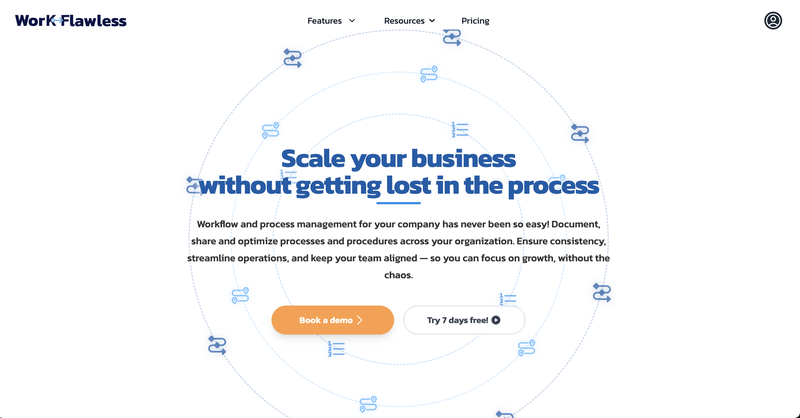
WorkFlawless stands out as a great solution for businesses seeking simplicity without sacrificing functionality and effectiveness.
The platform's goal is to provide businesses with a reliable SOP and workflow management tool which is easy to use and with an almost non-existent learning curve.
Instead of trying to do a little bit of everything like many of the more generalist tools out there that ultimately end up being project management platforms, it focuses on providing the features that really count, but in a very effective and user-friendly way. Their aim is to help organizations get up and running with their process documentation and management in minutes rather than countless hours.
WorkFlawless combines workflow diagrams, SOPs, and process maps into a unified platform that feels natural and immediate from the first interaction. The AI-powered workflow and SOP generation creates complete process documentation from simple prompts, while the interactive editors makes customization effortless. The platform's centralized hub eliminates scattered files and outdated procedures, ensuring everyone stays aligned without the typical administrative overhead.
What sets WorkFlawless apart is its focus on doing exactly what's needed without overwhelming users with unnecessary complexity, a philosophy that resonates strongly with growing businesses that want powerful results without the enterprise-level complications.
Main features:
- Interactive visual workflows that allows you to visually illustrate any business process in minutes.
- Standard Operating Procedures to document specific tasks in detail. They can then be linked from the workflows for comprehensive documentation.
- Custom Onboarding Paths, that allow you to combine Workflows and SOPs together to create a personalized onboarding for any team member.
Main pros:
- Intuitive interface with little to no learning curve
- Seamless combination of workflows, SOPs, and training paths in one single, centralized place
- Custom onboarding paths that can be built in minutes using drag-and-drop functionality
- AI-powered workflow and SOP generation that creates comprehensive documentation from simple prompts
- Migration service for existing processes and procedures
- Teams-focused approach, with customizable permissions and version control system.
- Scalable pricing structure and feature set that accompanies organizations as they grow.
SweetProcess
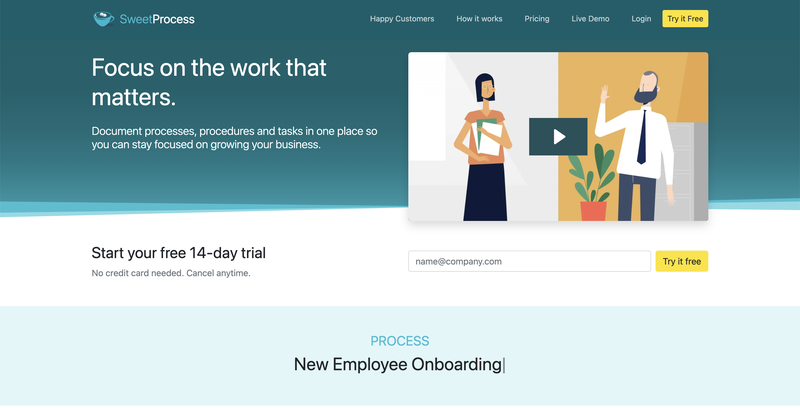
SweetProcess is another good option in the SOP tool landscape. The software's strength lies in its straightforward approach to process documentation. Designed with an intuitive, low-learning-curve interface, it enables companies to systematize their operations by transforming repetitive tasks and institutional knowledge into documented, actionable workflows. Its feature include procedures, processes, and policies, which can all be enhanced by AI-powered document generation. Beyond documentation, SweetProcess functions as a complete operational management system with task assignment and tracking, real-time progress monitoring, collaborative editing with approval workflows, and the ability to convert procedures into searchable knowledge bases for employees or customers.
Main pros:
- User-friendly interface that requires minimal technical knowledge
- AI feature that generates complete procedures from simple text prompts
- Robust multimedia support with easy drag-and-drop image and video integration
- Strong customer support with direct phone and email assistance
Scribe
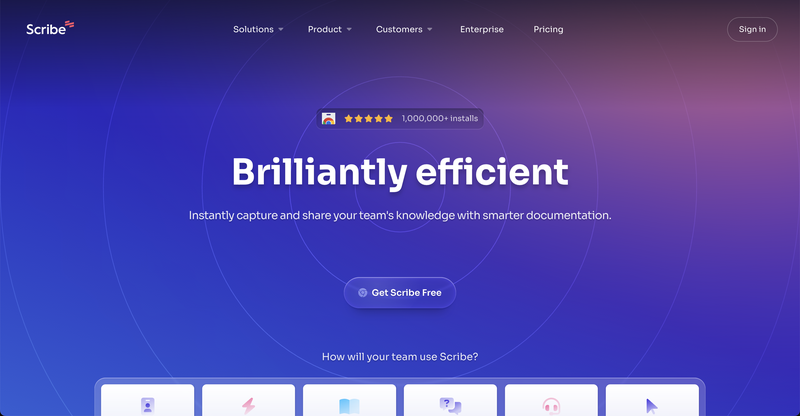
Scribe is a well-known and solid option for SOP creation through its innovative automatic documentation approach, transforming the traditionally time-intensive process into something that happens seamlessly in the background.
Their browser tool captures every click, keystroke, and navigation step while you perform tasks on the browser, automatically generating professional visual guides complete with annotated screenshots and detailed instructions.
The aim of Scribe lies in to eliminate the manual documentation burden entirely. The platform's browser extension integrates into existing workflows, requiring no disruption to established processes while building comprehensive documentation libraries.
Scribe's visual approach particularly benefits software-heavy environments where clear, step-by-step guidance with actual screenshots is proven to be a very effective documentation strategy. The automatic generation includes intelligent text descriptions alongside visual elements, creating documentation that works for different learning styles.
Main pros:
- Automatic screen capture for SOP recording directly from the browser
- Professional visual guides with annotated screenshots require no design skills
- Instant sharing capabilities through links, embeds, or PDF exports
- Built-in feedback system allows team collaboration on documentation improvement
Trainual
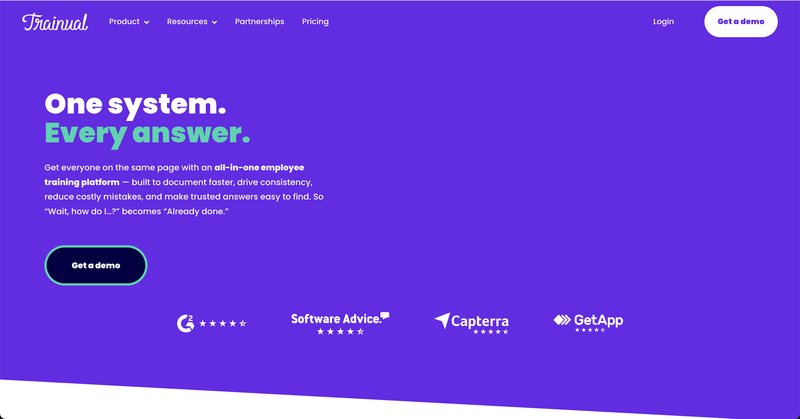
Trainual is a training and knowledge management solution for businesses. This platform goes beyond simple SOP documentation to create complete learning ecosystems that transform how organizations onboard, train, and develop their teams. The software's strength lies in its structured approach to knowledge transfer, with role-based content organization that ensures each team member receives exactly the information relevant to their position. Trainual particularly excels in environments where detailed training documentation and progress tracking are essential for business success and regulatory compliance.
Main pros:
- Comprehensive training ecosystem that goes well beyond SOP documentation
- Role-based content organization ensures relevant information delivery
- Strong integration capabilities with popular business tools and platforms
- Scalable platform that grows effectively with expanding teams
Process Street
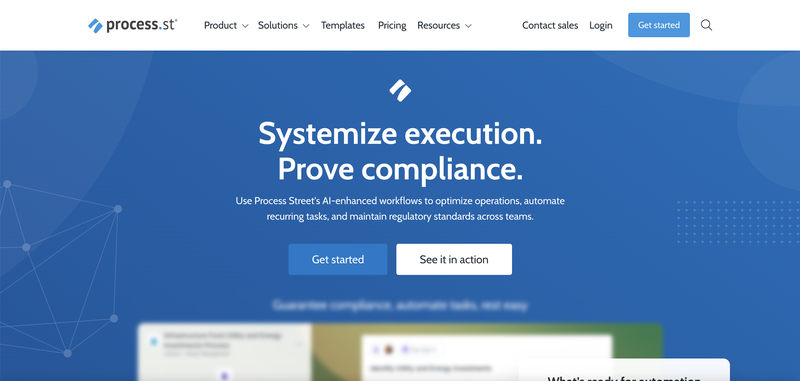
Process Street stands out by focusing on workflow automation and execution rather than simple documentation storage, making it a good option for businesses that need to ensure procedures are not just documented but actively followed. The software's checklist-based approach creates clear, actionable workflows that guide users through complex processes step-by-step while providing real-time visibility into progress and completion status. The platform's template library covers various business scenarios from employee onboarding to compliance audits, providing proven starting points for common organizational needs. Organizations particularly like Process Street's structured approach to procedure execution.
Main pros:
- Dynamic workflow execution with real-time progress tracking and visibility
- Powerful automation features including conditional logic and automated assignments
- Template library with proven workflows for common business scenarios
- Collaborative features enabling team-based workflow development and refinement
Document360
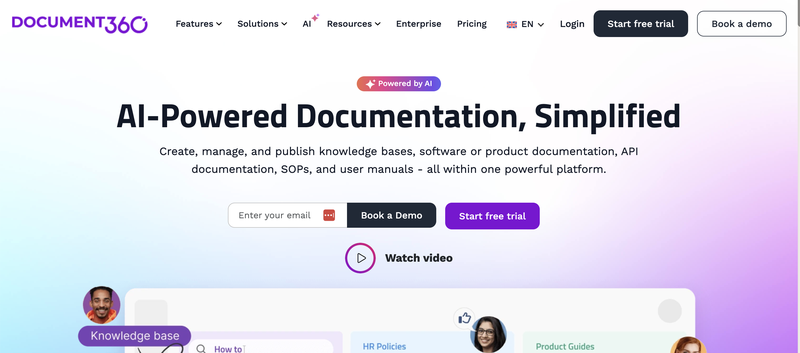
Document360's strength lies in its ability to handle complex documentation needs including multilingual support, advanced search capabilities, and sophisticated content organization systems. The collaborative features enable teams to work together on documentation development while maintaining version control and approval workflows. Recent enhancements have focused on improving AI accuracy and expanding integration capabilities, making Document360 increasingly attractive to businesses seeking cutting-edge documentation solutions. The platform's scalability makes it suitable for organizations planning significant growth while maintaining current usability for smaller teams.
Pros:
- AI assistant capable of generating documentation from multiple content types
- Multilingual support enabling global team collaboration and access
- Strong collaborative features with version control and approval workflows
- Modern, intuitive interface that balances powerful features with usability
Whale
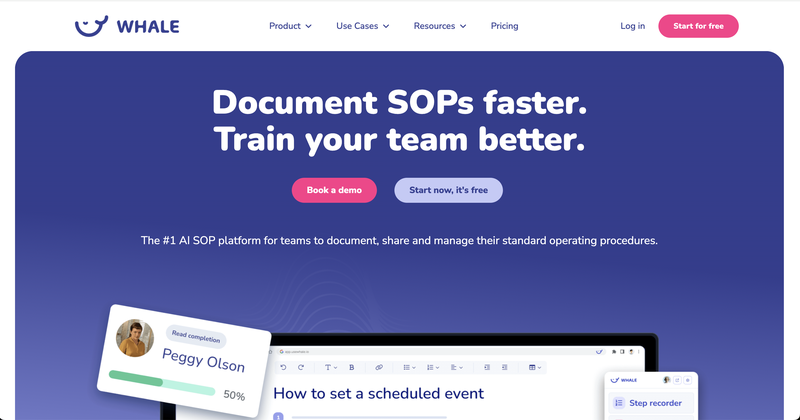
Whale is a platform that makes it easy to capture, share, and manage better process documentation. Designed as the central hub for all company processes, SOPs, playbooks, and policies, Whale helps teams quickly onboard, train, and set up their workforce for success. The platform combines traditional documentation capabilities with modern AI-driven features to streamline knowledge management and employee training. Core functionalities include the ability to quickly turn processes into clear, documented standard operating procedures, provide instant answers and clear instructions to support teams, and transform procedures into easy-to-follow training manuals. Additional features include an AI-powered virtual assistant trained on documented knowledge that can answer questions and analyze team performance, automatic document conversion that preserves structure and layout, and comprehensive integration capabilities.
Main pros:
- AI assistant which provides intelligent, context-aware answers to process questions
- Rapid deployment with immediate value demonstration and quick team adoption
- Browser extension delivers contextual suggestions without workflow disruption
- Extensive template library with industry-specific starting points for faster implementation
- Scalable platform that grows effectively with expanding teams and operations
Way We Do
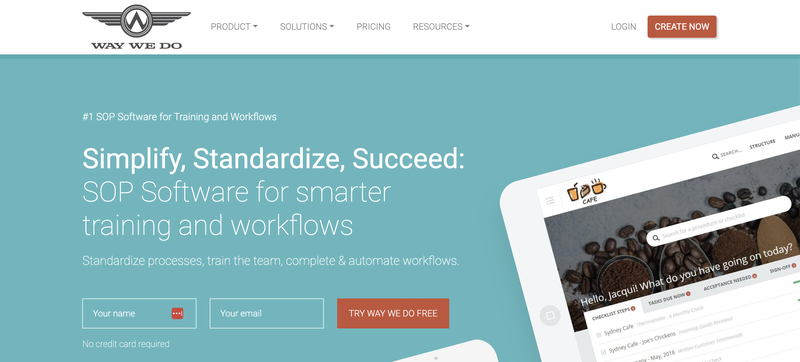
Way We Do positions itself as a comprehensive workflow and checklist management platform that transforms static procedures into interactive, trackable processes. This platform is good at creating activated checklists that guide users through complex procedures while providing management visibility into completion status and performance metrics. The platform's accountability features enable role assignment and responsibility tracking, ensuring that procedures are not just documented but actively followed by appropriate team members. Recent updates have focused on enhancing collaboration features and expanding integration capabilities, making Way We Do a good options for teams seeking comprehensive workflow management solutions.
Main pros:
- Activated checklists transform static procedures into trackable, manageable workflows
- Accountability features with role assignment and responsibility tracking capabilities
- Integrated task management combining procedure documentation with execution tracking
- Focus on process execution rather than just documentation storage
Tallyfy
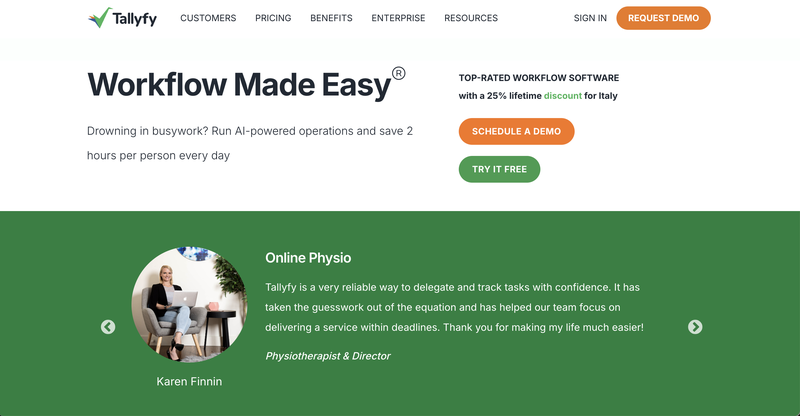
Tallyfy transforms traditional SOP documentation into workflows that eliminate the gap between procedure creation and execution. This platform focuses on turning static documents into living processes that teams can track, manage, and optimize in real-time. Tallyfy particularly excels in its ability to eliminate manual follow-ups and status checks through automated notifications and progress tracking. The template library provides starting points for common business scenarios while allowing extensive customization for specific organizational needs.
Main pros:
- Dynamic workflows with conditional logic adapting to specific business scenarios
- Automated notifications eliminating manual follow-ups and status checking requirements
- Template library with customizable starting points for common business processes
- Focus on process execution and automation rather than static documentation storage
- Scalable platform supporting simple checklists through complex multi-stage processes
Making the right choice for your business
Selecting the ideal SOP tool requires an assessment of your organization's current state, growth trajectory, and operational complexity. The most successful implementations occur when businesses match their actual needs with platform capabilities rather than choosing based on feature lists or popularity. Consider your team's technical comfort level, the complexity of your processes, and the level of automation you realistically need today versus what you aspire to achieve in the future.
The modern SOP landscape offers solutions for every business scenario. The key lies in understanding that the most powerful tool is worthless if your team won't adopt it, while the simplest solution may become limiting as your business grows. Start by clearly defining your primary pain points and prioritize platforms that directly address these challenges.
Let's not forget that successful SOP implementation extends beyond software selection to include change management, team training, and ongoing maintenance. The best platforms make this journey as smooth as possible through intuitive design, comprehensive support, and migration assistance. Consider starting with free trials or freemium options to test real-world compatibility before committing to long-term contracts. You can also request a demo where available to get an idea of what each platform does and ask any questions.
The investment in proper SOP software pays dividends through reduced training time, improved consistency, and scalable operations that grow with your business. The only mistake is waiting! Every day without standardized procedures costs time, money, and growth opportunities that your competitors are already capturing through effective process management.
Tired of scattered processes undermining your company's growth?
Transform scattered SOPs and unclear workflows into visual processes, automated training paths, and centralized documentation. Scale efficiently without the operational chaos.
Book a demo